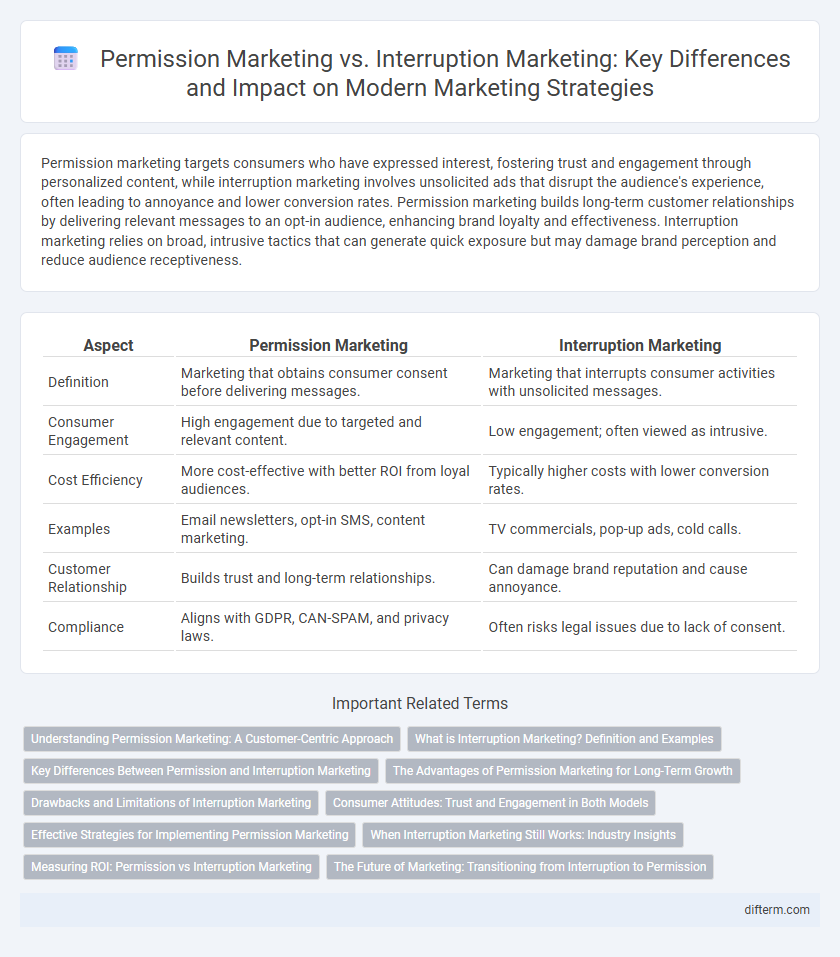Permission marketing targets consumers who have expressed interest, fostering trust and engagement through personalized content, while interruption marketing involves unsolicited ads that disrupt the audience's experience, often leading to annoyance and lower conversion rates. Permission marketing builds long-term customer relationships by delivering relevant messages to an opt-in audience, enhancing brand loyalty and effectiveness. Interruption marketing relies on broad, intrusive tactics that can generate quick exposure but may damage brand perception and reduce audience receptiveness.
Table of Comparison
| Aspect | Permission Marketing | Interruption Marketing |
|---|---|---|
| Definition | Marketing that obtains consumer consent before delivering messages. | Marketing that interrupts consumer activities with unsolicited messages. |
| Consumer Engagement | High engagement due to targeted and relevant content. | Low engagement; often viewed as intrusive. |
| Cost Efficiency | More cost-effective with better ROI from loyal audiences. | Typically higher costs with lower conversion rates. |
| Examples | Email newsletters, opt-in SMS, content marketing. | TV commercials, pop-up ads, cold calls. |
| Customer Relationship | Builds trust and long-term relationships. | Can damage brand reputation and cause annoyance. |
| Compliance | Aligns with GDPR, CAN-SPAM, and privacy laws. | Often risks legal issues due to lack of consent. |
Understanding Permission Marketing: A Customer-Centric Approach
Permission marketing centers on gaining explicit consent from customers before delivering promotional messages, ensuring communication aligns with their interests and preferences. This customer-centric approach fosters trust, increases engagement, and enhances brand loyalty by respecting user autonomy and reducing the annoyance associated with unsolicited ads. Effective permission marketing leverages data-driven insights to personalize experiences, resulting in higher conversion rates compared to traditional interruption marketing tactics.
What is Interruption Marketing? Definition and Examples
Interruption marketing is a traditional advertising approach that captures consumer attention through unsolicited messages such as TV commercials, pop-up ads, telemarketing calls, and banner ads. This method often disrupts the audience's experience, aiming for immediate engagement rather than building long-term relationships. Examples include cold-calling, radio ads, and forced video pre-rolls that interrupt content consumption.
Key Differences Between Permission and Interruption Marketing
Permission marketing targets consumers who have explicitly consented to receive promotional content, resulting in higher engagement and trust. Interruption marketing relies on unsolicited advertisements like pop-ups and TV commercials, often causing annoyance and lower conversion rates. Permission marketing leverages personalized communication based on user preferences, while interruption marketing uses broad, non-targeted messaging.
The Advantages of Permission Marketing for Long-Term Growth
Permission marketing fosters trust and builds stronger customer relationships by engaging audiences who have opted in, leading to higher conversion rates and brand loyalty. It enables personalized communication, increasing relevance and customer satisfaction, which drives repeat business and long-term revenue growth. Utilizing data-driven insights, businesses can refine targeting strategies in permission marketing, resulting in cost-efficient campaigns and sustainable marketing success.
Drawbacks and Limitations of Interruption Marketing
Interruption marketing often leads to consumer irritation and reduced brand trust due to its intrusive nature, frequently disrupting user experiences without consent. This approach suffers from low engagement rates as audiences increasingly utilize ad blockers and skip commercials to avoid unwanted messages. Additionally, interruption marketing can result in higher costs with lower return on investment compared to more targeted, permission-based strategies.
Consumer Attitudes: Trust and Engagement in Both Models
Permission marketing fosters higher consumer trust by respecting user consent and preferences, leading to increased engagement rates and brand loyalty. In contrast, interruption marketing often triggers negative attitudes due to unsolicited exposure, reducing trust and provoking ad avoidance behaviors. Brands leveraging permission marketing benefit from more meaningful interactions, resulting in sustained consumer relationships and improved campaign effectiveness.
Effective Strategies for Implementing Permission Marketing
Permission marketing relies on obtaining explicit consent from consumers before delivering promotional messages, enhancing engagement and trust. Effective strategies include personalized content, targeted email campaigns, and value-driven offers that encourage subscribers to opt-in and remain active. Leveraging data analytics to segment audiences and tailor communications maximizes conversion rates and fosters long-term customer loyalty.
When Interruption Marketing Still Works: Industry Insights
Interruption marketing remains effective in industries with high brand competition and short consumer attention spans, such as entertainment and fast-moving consumer goods. Brands using targeted TV ads or social media pop-ups can quickly capture wide audiences, generating immediate awareness and sales spikes. Data from Nielsen confirms that 70% of consumers recall brands from interruption ads, highlighting its ongoing relevance despite the rise of permission marketing.
Measuring ROI: Permission vs Interruption Marketing
Measuring ROI in permission marketing typically yields higher accuracy due to targeted audience engagement and consent-based communication, leading to increased conversion rates and customer loyalty. Interruption marketing often shows lower ROI as it relies on broader, less personalized outreach that can result in higher costs and diminished consumer receptivity. Data analytics reveal that permission marketing campaigns can achieve up to 3 times higher ROI by fostering trust and relevance compared to interruption marketing methods.
The Future of Marketing: Transitioning from Interruption to Permission
The future of marketing hinges on shifting from interruption marketing to permission marketing, emphasizing consumer consent and engagement over intrusive tactics. Brands leveraging data-driven personalization and opt-in strategies foster trust and higher conversion rates by aligning marketing efforts with audience preferences. This transition enhances customer loyalty, reduces ad fatigue, and optimizes ROI through targeted, relevant communication.
Permission marketing vs interruption marketing Infographic

 difterm.com
difterm.com